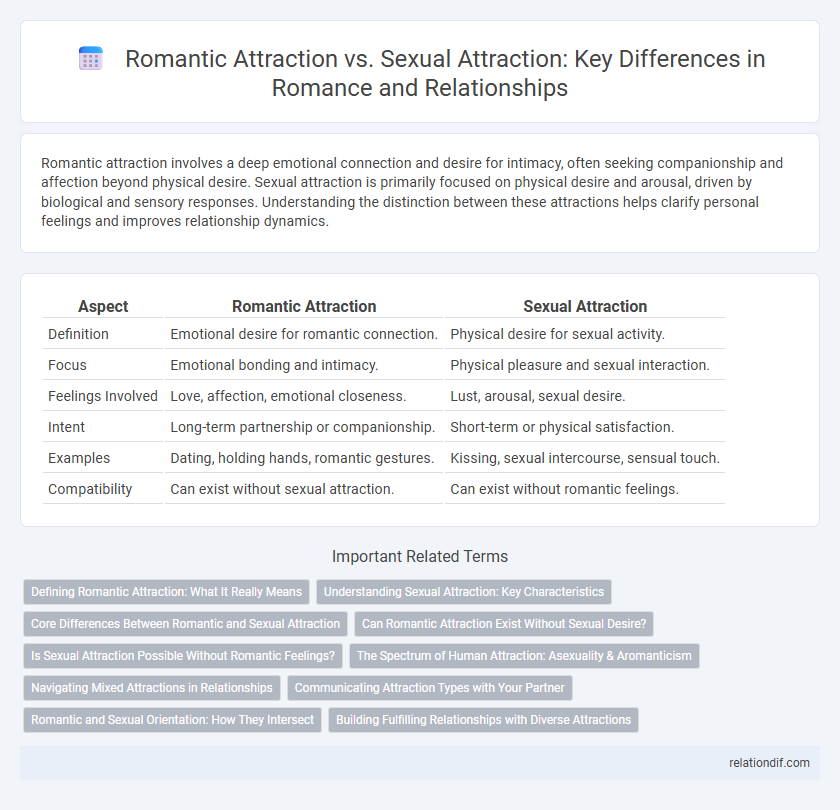Romantic attraction involves a deep emotional connection and desire for intimacy, often seeking companionship and affection beyond physical desire. Sexual attraction is primarily focused on physical desire and arousal, driven by biological and sensory responses. Understanding the distinction between these attractions helps clarify personal feelings and improves relationship dynamics.
Table of Comparison
| Aspect | Romantic Attraction | Sexual Attraction |
|---|---|---|
| Definition | Emotional desire for romantic connection. | Physical desire for sexual activity. |
| Focus | Emotional bonding and intimacy. | Physical pleasure and sexual interaction. |
| Feelings Involved | Love, affection, emotional closeness. | Lust, arousal, sexual desire. |
| Intent | Long-term partnership or companionship. | Short-term or physical satisfaction. |
| Examples | Dating, holding hands, romantic gestures. | Kissing, sexual intercourse, sensual touch. |
| Compatibility | Can exist without sexual attraction. | Can exist without romantic feelings. |
Defining Romantic Attraction: What It Really Means
Romantic attraction involves the desire to form a deep emotional connection and intimate bond with someone, often characterized by affection, longing, and the wish to spend quality time together. It differs from sexual attraction, which is primarily driven by physical desire and sexual interest toward another person. Understanding romantic attraction is crucial for recognizing diverse relationship orientations and fostering meaningful connections beyond physical intimacy.
Understanding Sexual Attraction: Key Characteristics
Sexual attraction is characterized by a physical desire or arousal toward another person, often involving the anticipation of sexual activity. It differs from romantic attraction, which centers on emotional connection and intimacy without necessarily involving sexual desire. Key indicators of sexual attraction include physiological responses, such as increased heart rate and focus on physical attributes, highlighting the distinct nature of this drive in human relationships.
Core Differences Between Romantic and Sexual Attraction
Romantic attraction involves an emotional desire for closeness, affection, and meaningful connection with a person, often independent of physical desire. Sexual attraction centers on the physical urge or desire to engage in sexual activities with someone, driven primarily by biological and physical cues. Understanding the core differences is essential for recognizing diverse orientations such as asexuality and aromanticism, where an individual may experience one type of attraction but not the other.
Can Romantic Attraction Exist Without Sexual Desire?
Romantic attraction can exist independently of sexual desire, as many individuals experience deep emotional connections without physical longing. Asexual and aromantic spectrums highlight varied experiences where romantic feelings are distinct from sexual urges. This separation underscores the complexity of human relationships, validating the existence of romantic bonds absent of sexual intent.
Is Sexual Attraction Possible Without Romantic Feelings?
Sexual attraction can exist independently of romantic feelings, as individuals may experience physical desire without emotional attachment. Studies in human sexuality highlight that sexual attraction is primarily driven by biological and physical stimuli, while romantic attraction involves emotional connection and intimacy. This distinction helps explain why some people identify as aromantic but still experience sexual attraction, underscoring the complexity of human desire.
The Spectrum of Human Attraction: Asexuality & Aromanticism
Romantic attraction involves an emotional desire for a deep connection or partnership, while sexual attraction focuses on physical interest and desire. The spectrum of human attraction includes asexuality, characterized by little or no sexual attraction, and aromanticism, defined by little or no romantic attraction, highlighting the diverse ways individuals experience relationships. Understanding this spectrum is crucial for recognizing and respecting varied interpersonal connections beyond traditional norms.
Navigating Mixed Attractions in Relationships
Navigating mixed attractions in relationships requires understanding the distinctions between romantic attraction, which involves emotional intimacy and a desire for partnership, and sexual attraction, characterized by physical desire and gratification. Recognizing these differences allows partners to communicate their needs clearly and establish boundaries that honor both romantic and sexual dimensions. Balancing mixed attractions fosters healthier relationships by promoting empathy, respect, and personalized connection strategies tailored to each individual's unique experience of attraction.
Communicating Attraction Types with Your Partner
Clearly distinguishing between romantic and sexual attraction is crucial for fostering trust and understanding in relationships. Use precise language to express your feelings, such as describing emotional intimacy for romantic attraction and physical desire for sexual attraction. Open dialogue about each partner's unique experiences with attraction can strengthen emotional connection and ensure both partners' needs are acknowledged and respected.
Romantic and Sexual Orientation: How They Intersect
Romantic attraction refers to the desire for emotional intimacy and romantic connection, while sexual attraction involves physical desire and sexual interest. Romantic and sexual orientations may align or differ within an individual, highlighting the complex nature of identity, such as a person identifying as heteroromantic but asexual. Understanding the intersection of romantic and sexual orientation enhances awareness of diverse experiences beyond traditional attraction models.
Building Fulfilling Relationships with Diverse Attractions
Romantic attraction involves the desire for emotional intimacy and deep connection, while sexual attraction pertains to physical desire and arousal. Building fulfilling relationships requires recognizing and respecting these distinct attractions, allowing partners to express their needs authentically. Embracing diverse attractions fosters open communication, trust, and mutual understanding, essential for lasting and satisfying bonds.
Romantic attraction vs Sexual attraction Infographic

 relationdif.com
relationdif.com